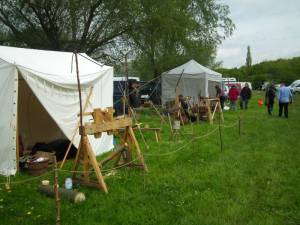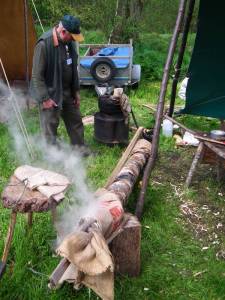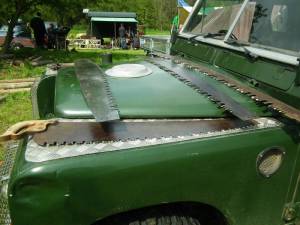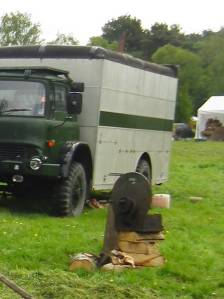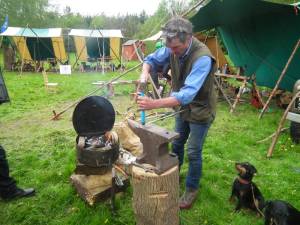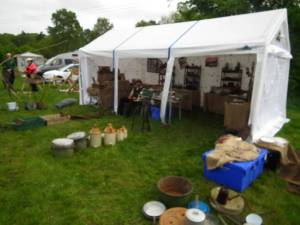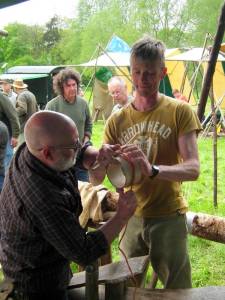……the Bodgers Ball 2015 that is. Every year hundreds of Greenwood workers get together in a field somewhere in the UK to share skills, catch up with old friends, meet new ones, compete, try out new ideas and to generally have a ball! This year we were invited to the heart of Sherwood Forest by the East Midlands and Derbyshire local groups of the Bodgers. Here is a quick romp through some photos of the ball as I saw it.
I took my steamer to demonstrate steam bending a traditional English scythe snathe. Full steam up as Graham inspects the washing machine drum stove with the old petrol tank boiler mounted on top.
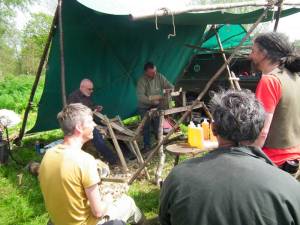 Just as well I came fully equipped. It wasn’t long before friends moved in with lathe, shave horse and steamer all in use.
Just as well I came fully equipped. It wasn’t long before friends moved in with lathe, shave horse and steamer all in use.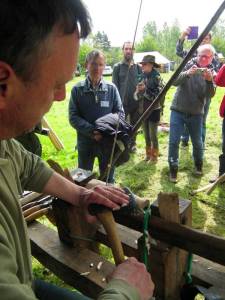
Sean Hellman didn’t bring a lathe and had to make do with mine to turn an egg for the egg and spoon race. He didn’t bring his chisels either – is that an axe he’s turning the egg with? 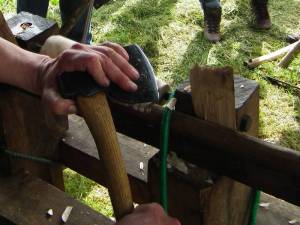 First time for everything, who needs chisels on a pole lathe for turning an egg. Not Sean!
First time for everything, who needs chisels on a pole lathe for turning an egg. Not Sean!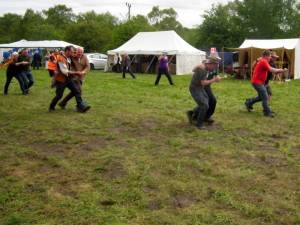 With the egg turned and a spoon carved the teams finished the race three legged. Crazy competition it could only be at a bodgers ball.
With the egg turned and a spoon carved the teams finished the race three legged. Crazy competition it could only be at a bodgers ball.
Merlin from Somerset brought along a good selection of cross cut saws. Almost as fine as the Series 3 they are sitting on. Merlin is turning into a fine saw doctor especially with the big greenwood raker teeth on the crosscuts and if your saw could do with some TLC you can contact him in the West Country via the Cherrywood Project near Bath.
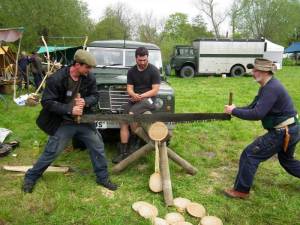 Power tools are banned for the duration of the Ball (not just for the insurance it’s also the ethos of the event) and the cross cut saws made quick work of any sawing needed as well allowing people to have a go.
Power tools are banned for the duration of the Ball (not just for the insurance it’s also the ethos of the event) and the cross cut saws made quick work of any sawing needed as well allowing people to have a go.
Moving up a step from the Landrovers Simon Damant came very well equipped with his ex fire brigade 4WD Bedford MJ. We were grateful for the stove when it poured down on the Friday night, though the various concoctions of calvados, distilled mead and blackcurrent vodka may have been partly responsible. Simon – you really must get some steps to stop me falling out of the truck next time!
Fully equipped with a portable forge as well and some bags of charcoal to run the hearth.
Simon gave a demonstration making a rams head hook and also took part in the half hour challenge where competitors have 30 minutes to make something saleable.
Richard Roods emporium is becoming a firm favourite at the ball and it’s a rare event where I go home with less than I brought with me.
 This year was no exception as Richard had been putting aside knackered old English scythes for me all year. Avoiding lugging this lot back calls for desparate measures!
This year was no exception as Richard had been putting aside knackered old English scythes for me all year. Avoiding lugging this lot back calls for desparate measures!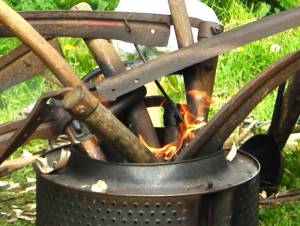
What’s all this then? Heretic? Have I given up on the English Scythe? No, not at all. I just want the ironwork, the eye bolts, scythe rings, nibs and one or two of the blades for rebuilding onto my newly made snathes – the woodwork and especially the livestock (woodworm) are not welcome. Although this fire is mainly for effect I did burn up two snathes in steaming the new snathe which seems quite appropriate to me as the old is used to help make the new.
Steve and Nigel hijacked my steamer to steam some rings of chestnut. Will they reveal what they are planning to do with them?
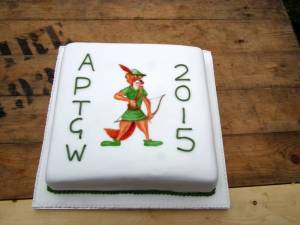 The climax of the weekend are the half hour challenge and the log to leg races on the Sunday afternoon. Simon and Kate joined me and we came a creditable third in the team log to leg race and I was very pleased to come third in the individual log to leg race. That just left cutting the cake and suddenly and far far too soon it was the end of another fine bodgers ball. Just another 360 days to go until the next one. But the Somerset Scythe Festival is a lot closer – only 4 weeks away. No rest for the even slightly naughty around here…..
The climax of the weekend are the half hour challenge and the log to leg races on the Sunday afternoon. Simon and Kate joined me and we came a creditable third in the team log to leg race and I was very pleased to come third in the individual log to leg race. That just left cutting the cake and suddenly and far far too soon it was the end of another fine bodgers ball. Just another 360 days to go until the next one. But the Somerset Scythe Festival is a lot closer – only 4 weeks away. No rest for the even slightly naughty around here…..
